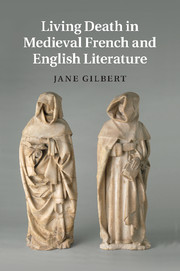Book contents
- Frontmatter
- Contents
- Acknowledgements
- Note on translations
- Introduction: living death
- 1 Roland and the second death
- 2 The knight as Thing: courtly love in the non-cyclic prose Lancelot
- 3 The ubi sunt topos in Middle French: sad stories of the death of kings
- 4 Ceci n'est pas une marguerite: anamorphosis in Pearl
- 5 Becoming woman in Chaucer: on ne naît pas femme, on le devient en mourant
- Conclusion: living dead or dead-in-life?
- Notes
- Bibliography
- Index
- Cambridge Studies in Medieval Literature
4 - Ceci n'est pas une marguerite: anamorphosis in Pearl
Published online by Cambridge University Press: 01 March 2011
- Frontmatter
- Contents
- Acknowledgements
- Note on translations
- Introduction: living death
- 1 Roland and the second death
- 2 The knight as Thing: courtly love in the non-cyclic prose Lancelot
- 3 The ubi sunt topos in Middle French: sad stories of the death of kings
- 4 Ceci n'est pas une marguerite: anamorphosis in Pearl
- 5 Becoming woman in Chaucer: on ne naît pas femme, on le devient en mourant
- Conclusion: living dead or dead-in-life?
- Notes
- Bibliography
- Index
- Cambridge Studies in Medieval Literature
Summary
The Pearl-Maiden is dead. Cutting through the Jeweller's elaborate, indeterminate metaphors (ll. 9–10), she insists on the fact by repeated references to the rotting of her corpse (ll. 857, 958). Jean-Claude Schmitt notes that revenants (returned spirits of the departed) often materialize in medieval texts in response to some irregularity in the dying process which hampers their progress within the afterlife, typically an unconfessed sin, a wrong left unrighted or an unpaid debt. This, as the Pearl-Maiden explains to the Jeweller, is not her case. The notion that her death, untimely to him, represents an acme of Christian aspiration is one of many shifts of perspective that he has to confront in the course of the poem. She died innocent and is therefore ‘saf by ryƷt’ (l. 684; ‘saved by right’), having incurred no debts. Her spirit has been incorporated properly – indeed, ideally – into the society of the afterlife. As a Christian she has, in leaving the flesh, been subtracted from death; for, as baptism replaces birth as the commencement of life in the spirit, so bodily death is superseded by ‘þe deth secounde’ (l. 652; ‘the second death’) of damnation or spiritual death, from which Christ's sacrifice releases the baptized. For the first time in this book, we encounter the extremist Christian opposition between corporeal and spiritual life. For the elect there is no spiritual death.
- Type
- Chapter
- Information
- Living Death in Medieval French and English Literature , pp. 151 - 190Publisher: Cambridge University PressPrint publication year: 2011



